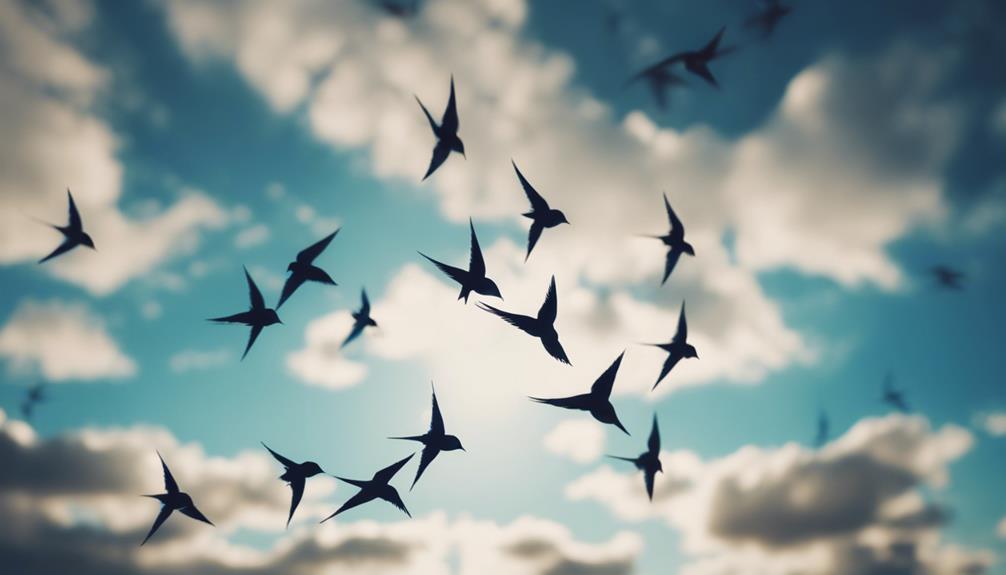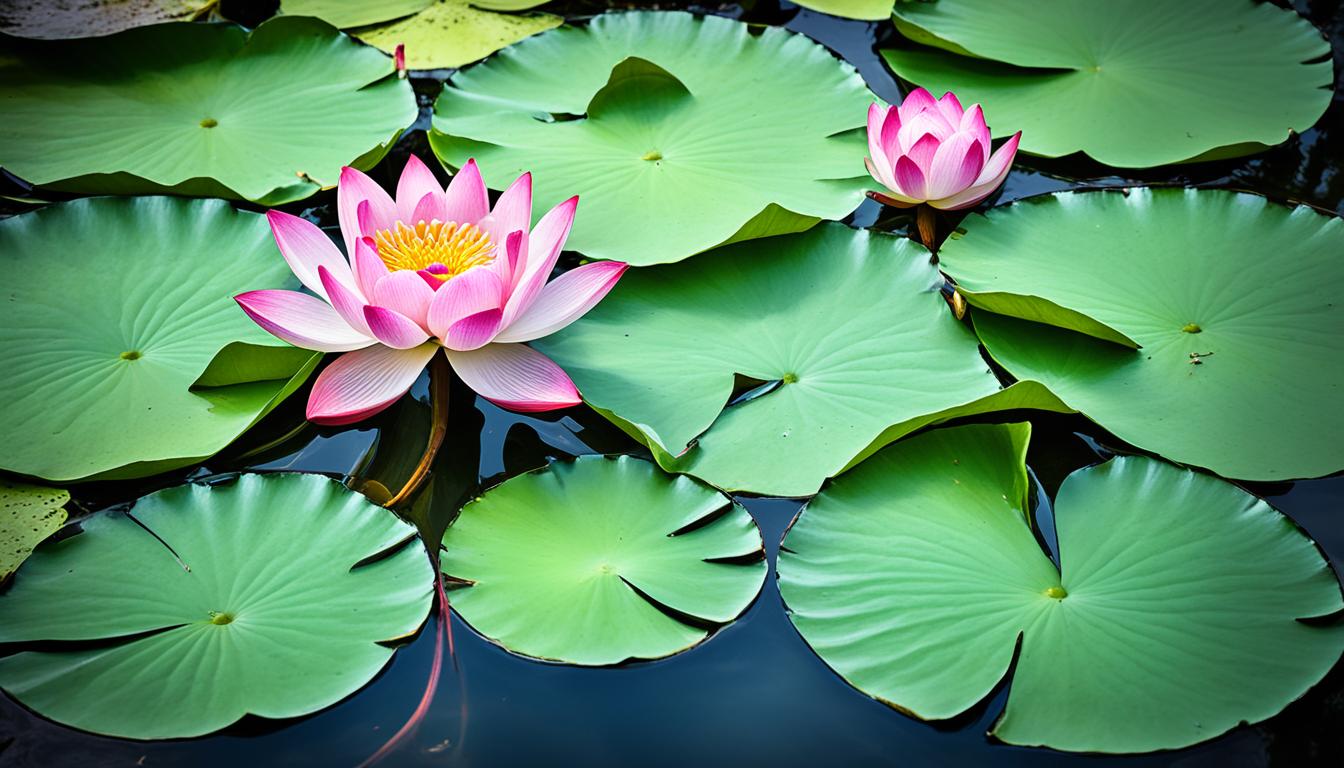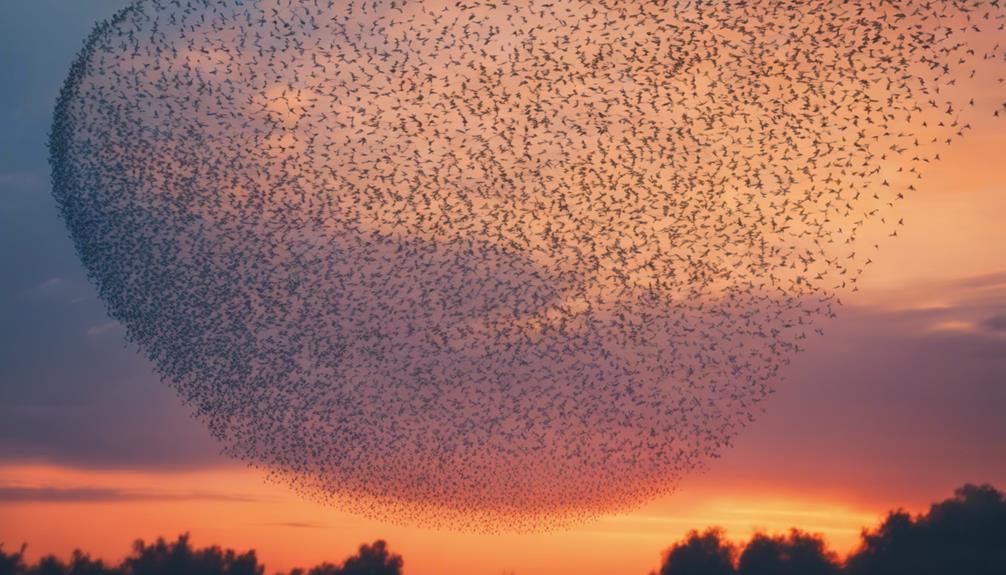The monarch butterfly migration showcases nature’s living metaphor of resilience and interconnectedness. Each year, millions undertake a long journey, relying on healthy habitats and native plants like milkweed. Their migration depends on habitat restoration and conservation efforts that help protect these incredible pollinators. As you explore further, you’ll discover how supporting native plants and community actions can guarantee this natural wonder continues for generations to come.
Key Takeaways
- Monarch migration exemplifies resilience, adaptation, and the interconnectedness of ecosystems, serving as a powerful natural metaphor.
- Their long, multi-generational journey symbolizes hope, perseverance, and the cyclical nature of life.
- Habitat restoration efforts mirror broader themes of renewal and environmental stewardship within the migration process.
- Monarchs’ dependence on specific plants like milkweed highlights the importance of ecological balance and conservation.
- The migration inspires cultural appreciation for nature’s resilience and the need to protect pollinators and habitats.

Every year, millions of monarch butterflies set out on a remarkable journey southward to escape the cold winter and find suitable breeding grounds. This migration isn’t just a marvel of nature; it’s a essential process that highlights the importance of pollinator conservation. As you consider this incredible feat, remember that the survival of these butterflies depends heavily on the health of their habitats. Without careful habitat restoration efforts, their populations could decline, threatening not only monarchs but the broader ecosystems that rely on pollinators.
Every year, monarch migration depends on healthy habitats and pollinator conservation efforts.
During their migration, monarch butterflies rely on specific plants—particularly milkweed—for laying eggs and nurturing their caterpillars. The decline of milkweed due to urban development, pesticide use, and monoculture farming directly impacts their ability to sustain their populations. By supporting pollinator conservation initiatives, you help guarantee that these critical plants are preserved and restored. Creating butterfly-friendly gardens, planting native milkweed, and reducing pesticide use can vastly boost their chances of survival. Habitat restoration becomes a practical way for you to contribute, as restoring native plant communities provides essential resources for monarchs along their migratory route.
The journey itself is fraught with challenges, from harsh weather to loss of habitat. You can help mitigate these threats by advocating for policies that protect natural corridors and migratory pathways. Public awareness and community involvement are essential; they can foster a collective effort toward conserving the landscapes monarchs depend on. By participating in habitat restoration projects, you directly contribute to creating safe havens along their migration route. Restoring wildflower meadows, roadside verges, and degraded lands not only benefits monarchs but also supports other pollinators like bees and butterflies, enriching biodiversity. Additionally, planting native plant species can significantly enhance the availability of resources for migrating monarchs.
Understanding the importance of pollinator conservation extends beyond supporting individual species. Monarchs serve as a living metaphor for resilience and the interconnectedness of ecosystems. Their migration demonstrates how different habitats, plants, and animals depend on each other for survival. When you take steps to restore habitats and promote pollinator-friendly practices, you’re actively participating in the preservation of this delicate balance. Your efforts help guarantee that future generations can witness this awe-inspiring migration, reinforcing the essential role that pollinators play in maintaining healthy, thriving environments. In essence, by protecting monarchs and their habitats, you’re safeguarding a natural wonder that embodies the resilience and interconnectedness of life on Earth.
Frequently Asked Questions
How Do Monarchs Navigate During Their Long Migrations?
You might wonder how monarchs find their way during long migrations. They use magnetic navigation, sensing Earth’s magnetic field to help orient themselves. Additionally, celestial cues like the sun and stars guide their flight paths. By combining these natural navigation tools, monarchs can travel thousands of miles accurately, ensuring they reach their breeding grounds. This incredible ability showcases nature’s mastery in guiding these remarkable butterflies across vast distances.
What Are the Main Threats to Monarch Butterfly Populations?
Imagine a delicate dance interrupted—your favorite butterfly’s flight threatened. Habitat loss and pesticide use are the main threats to monarch populations, shrinking their safe spaces and poisoning their food sources. These dangers act like shadowy predators, reducing their numbers and disrupting their migration. To protect these vibrant travelers, we must reduce pesticide use and preserve natural habitats, ensuring their journey continues and their colors brighten the skies once more.
How Long Does the Entire Migration Process Take?
You might wonder about the migration duration and seasonal timing of monarch butterflies. Typically, the entire migration process takes about 3 to 4 months. It begins in late summer or early fall when they leave their summer breeding grounds and heads south to warmer areas like Mexico or California. Then, in spring, they return north, following seasonal timing that aligns with temperature and food availability.
Do Monarch Butterflies Migrate at Night or During the Day?
You might wonder if monarch butterflies migrate at night or during the day. They primarily migrate during the day, using sunlight to guide their journey. Their butterfly wing patterns help them stay visible and avoid predators. Their monarch breeding habits, including timing and location, influence migration timing, but they rely on daylight to navigate effectively. Night migration is rare for monarchs, as daylight provides essential cues for their long journey.
Can Monarch Butterflies Migrate in Urban Environments?
Did you know monarchs can navigate through urban obstacles? Yes, they do migrate in city environments, often taking advantage of city gardens and parks. Despite challenges like tall buildings and artificial lights, they adapt remarkably. You might see them fluttering through urban areas, especially during migration seasons. These butterflies use the sun’s position and other cues, proving that even in cities, nature’s travelers find their way, inspiring everyone who observes them.
Conclusion
As you witness the wondrous whirl of wandering monarchs, remember their remarkable migration mirrors life’s perpetual pursuit of purpose. Their delicate dance demonstrates determination, destiny, and devotion, inspiring you to embrace your own journey. Let their fleeting flight fuel your fascination, fueling faith in nature’s nonstop, serendipitous symphony. So, stand in awe of this breathtaking ballet, and carry their courageous course in your heart, celebrating the ceaseless cycle of survival and stunning spectacle.











